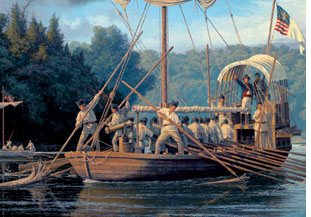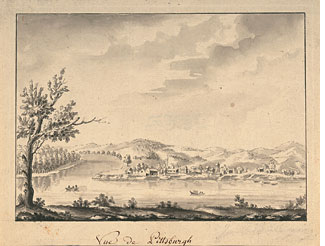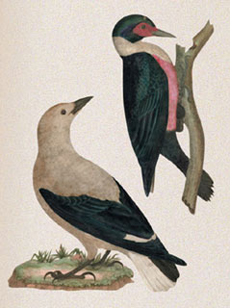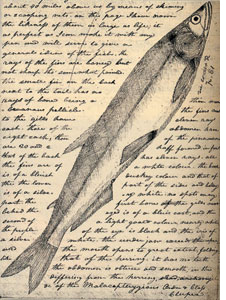Space Exploration
in 1803:
The Lewis and Clark Expedition
By Robert J. Gangewere
 Lewis
and Clark: The Departure from the Wood River
Encampment,
May 14, 1804, a painting by Gary R. Lucy. The expedition
begins its journey up the untamed Missouri River after
wintering
on the United States side of the Mississippi. Lewis
and Clark: The Departure from the Wood River
Encampment,
May 14, 1804, a painting by Gary R. Lucy. The expedition
begins its journey up the untamed Missouri River after
wintering
on the United States side of the Mississippi.
The “Corps of Discovery” dispatched
by President Thomas Jefferson in 1803 was the first
scientific expedition ever undertaken by the United
States—the
prototype of all national scientific enterprises,
including today’s missions into outer
space. Not surprisingly, the expedition had
its critics,
and Jefferson had
to persuade Congress to appropriate $2,500
for the adventure.
He helped select the launch point: Pittsburgh. This year is the bicentennial of that early exploration
into uncharted space, and Pittsburgh’s
special day in the national calendar of celebration
is
August 31, the very day that Captain Meriwether
Lewis put
his Pittsburgh-built keelboat into the Monongahela
River
and directed his crew to start rowing west down
the Ohio towards the Pacific. The city’s celebration is being spearheaded
by the Historical Society of Western Pennsylvania,
which
will have a special exhibit (including a replica
of the Pittsburgh-built keelboat), and has
collaborated with
other groups to stage a river flotilla and
celebrations at the Pittsburgh Point. Carnegie Museum
of Natural
History is installing a year-long Lewis and
Clark exhibit,
and
Carnegie Science Center is featuring the expedition
at the Rangos Ominmax Theater and in a skyshow
at Henry Buhl, Jr. Planetarium and Observatory. 1803:Politics and a New Frontier
That summer in Pittsburgh,
Lewis sup-ervised the building of the keelboat he had
specially
designed, and collected the tons of supplies
and trade goods to outfit the journey. Pittsburgh
was the Gateway to
the West, but more than
a thousand miles away near St. Louis, where
the Missouri emptied into the Mississippi,
the unknown
frontier really
began. After wintering across from St. Louis
in 1803-04, on the American side of the Mississippi,
the Corps of
Discovery started the second leg of its journey
by rowing up the Missouri on May 14. The years
1803-04 were a turning point in American history,
full of geopolitical pressure,
commercial
dreams, and
scientific promise. The British in Canada
had been moving to outflank the United
States by
exploring
and claiming
vast tracts of land west of the Mississippi.
In France, Napoleon countered the expanding
British Empire by
suddenly selling the “Louisiana Territory” to
the United States. The money helped him
finance another war
against Great Britain, and when the sale
was completed, Napoleon boasted, “I
have just given England a rival that will
sooner or later humble her pride.” Jefferson,
elected the third president in 1801, quickly
borrowed $15 million,
a sum
nearly
twice the American
budget, to buy all 820,000 acres from France.
With the stroke of his pen he more than
doubled the
size of his
country at three cents an acre. But few
Americans knew anything about the land
he bought, and
his critics called it “shameful gross
speculation,” and complained
that the United States had no more right
to this land than to “land in the
moon.” The Louisiana
Purchase added a political justification
for the Lewis and Clark expedition. Jefferson,
like others, believed there was a Northwest
Passage to discover—some river or
a series of rivers connected by a short
portage over the mountains —-that
would take explorers to the Pacific, and
make possible direct Amer-ican trade with
the Orient. He wanted to
expand national commerce, open up the fur
trade, and develop new frontier settlements.
And he was passionate
about scientific discovery—so much
so that he had tried several times in the
previous 20 years
to
get scientists
to explore the Pacific Northwest, but had
always failed. Jefferson appointed his personal
secretary and fellow Virginian, Meriwether
Lewis, to
be Captain of the expedition,
and he had Lewis
take
crash courses in science in Philadelphia,
the American center
of science. Lewis was tutored by the nation’s
best botanists, astronomers, anatomists,
and physicians. He
learned
to describe and preserve botanical specimens,
to analyze anatomy, to navigate by the
stars, to determine latitude
and longitude, to identify fossils, and
perform basic medical procedures, such
as bloodletting. The Pittsburgh Launch
Lewis had designed a modified
keelboat as the vehicle for
his mission, and he oversaw its construction,
probably at
the Greenough boatyard near the present
Liberty Bridge. Unfortunately, the boat
builder was
a drunkard and a
liar, involved in disputes with his workers,
and the construction took a month and a
half beyond the scheduled
time of departure. Lewis went through an
agony of frustration as the Ohio River
dried up and
became unnavigable in
August, seemingly dooming his mission.
Local rivermen complained that the river
was lower
than anyone could
remember, and every day Lewis pleaded or
threatened the boat builder to complete
the job.
 View of Pittsburgh in 1797, by Joseph Warin.
The keelboat was built on the banks of the
Monongahela six years later. Courtesy of The
New York Public Library. View of Pittsburgh in 1797, by Joseph Warin.
The keelboat was built on the banks of the
Monongahela six years later. Courtesy of The
New York Public Library.
To lighten the keelboat, Lewis
sent a wagonload of goods ahead to Wheeling.
He also bought
a flat-bottomed rowboat
with a sail—a pirogue—to carry
some of the goods. When the keelboat finally
slid into
the
water
at 7 a.m. on August 31st,
it was loaded quickly and the explorers
left Pittsburgh by 10 a.m. The first day
the expedition
made 10 miles,
after unpacking the keelboat three times
to haul it over sandbars.
At the first
stop, on Brunot’s island three
miles downriver, Lewis took time to demonstrate
his new air-gun,
a pneumatic rifle made in Philadelphia,
that fired without smoke or noise. While passing
this amazing
gun around,
it accidentally went off, wounding a woman
slightly in the temple. The explorers never
passed the loaded
gun
around again, and on the rest of the journey
they used it to amaze the Indians. In Pittsburgh
Lewis also bought a large dog, recording that
it was “of the Newfoundland breed very
active strong and docile.” He called
it “Seaman” and
it became his constant companion on water
and land. Seaman caught squirrels and other
animals (one
time he caught
a swimming antelope),
and he guarded the camp at night. Seaman’s
barking warned off prowling grizzly bears
in the western mountains.
Lewis refused to trade him to the Indians
who wanted him, and when some thieves stole
him, Lewis had
them tracked until they released the dog. A True Voyage of Discovery
Mary
Dawson, curator emeritus of Vertebrate Paleontology
at Carnegie Museum of Natural
History, points
out that, scientifically, this was a true “voyage
of discovery.” She
adds, “Although many animals and
plants in the wild had been seen by Native
Americans and
French explorers,
the small scientific community in the United
States had never attempted to collect and
describe them.
A new chapter
of natural history science was opened by
this expedition, and there were many consequences
from the notes
and specimens that Lewis and Clark sent
back. Within a decade there
were many discoveries of new species.”  Dawson
heads the museum’s preparation of
the bicentennial exhibit Natural History
of the Lewis and Clark Expedition,
1804-1806: The Corps of Discovery. This
exhibit presents ex-amples from the museum’s
collections of the species first noted
by Lewis and Clark. They described
in their journals 178 plants and 122 animals
not previously recorded, including animals
such as the grizzly bear,
antelope, the mule-deer, the kit-fox, coyote,
prairie dog, and mountain “beaver” of
the Pacific Northwest. Two of the new species
of birds identified
were “Lewis’ Woodpecker” (Melanerpes
lewis) and “Clark’s Nut-cracker” (Nucifraga
columbiana), in addition to the Bald Eagle,
California Condor, and the now extinct
Passenger Pigeon. Dawson
heads the museum’s preparation of
the bicentennial exhibit Natural History
of the Lewis and Clark Expedition,
1804-1806: The Corps of Discovery. This
exhibit presents ex-amples from the museum’s
collections of the species first noted
by Lewis and Clark. They described
in their journals 178 plants and 122 animals
not previously recorded, including animals
such as the grizzly bear,
antelope, the mule-deer, the kit-fox, coyote,
prairie dog, and mountain “beaver” of
the Pacific Northwest. Two of the new species
of birds identified
were “Lewis’ Woodpecker” (Melanerpes
lewis) and “Clark’s Nut-cracker” (Nucifraga
columbiana), in addition to the Bald Eagle,
California Condor, and the now extinct
Passenger Pigeon.
Among the trees recorded
were the ponderosa pine and the cottonwood,
and plants included
the bitterroot,
common arrowhead, and prickly pear cactus. “The
prickly pear is now in full blume and forms
one of the beauties
as well as the greatest pests of the plains,” wrote
Lewis. Its needles tortured men and
animals alike. On one frustrating day,
Lewis recorded, “It
now seemed to me that all the beasts of
the neighborhood had made league to destroy
me—I thought it
might be a dream, but the prickly pears
which pierced my
feet severely once in a while, particularly
after it grew
dark, convinced me I was really awake,
and that it was necessary to make the rest
of my way to
camp.” Insects were also a problem: “Our
trio of pests still invade and obstruct
us on all occasions, these
are Muskquetoes, eye gnats, and prickly
pears, equal to any three curses that ever
poor Egypt labored under,
except the Mohametant yoke.” The
wasps (Vespa diabolica) “are
fierce and sting very severely, so we found
them very troublesome in frightening our
horses as we
passed
the mountains.” The explorers also
collected fossils and rock specimens. Carnegie
Museum of Natural
History’s Section
of Invertebrate Paleontology is planning
a virtual tour
on its web site to illustrate key fossil
collecting sites, and important geologic
exposures along the
trail of the
Corps of Discovery. By the time they reached
North Dakota and built Fort Mandan, Lewis
and Clark had
some 40 men
under their
command, and traveled in the big keelboat
with two canoes and
two pirogues. But after wintering there
in 1804-05, they returned some men back
to St.
Louis with
the keelboat, which they filled with natural
specimens,
maps, and
reports
of their travels. From North Dakota a smaller
party headed to the Pacific over the mountains,
walking,
riding, paddling
canoes and boats—whatever would take
them to the ocean. A Report that Sparked Immigration
Jefferson, anxious
about the success of the mission, had not heard
directly from
his Corps
for
a long time
when he finally received back in Washington
the evidence of their travels and the first
collected specimens.
The first report, some 45,000 words, summarized
meetings with 72 native tribes, assessments
of trading and settlement
possibilities, and included four wooden boxes
and a large trunk full of specimens such
as skins, skeletons,
mineral samples, and Indian corn. There were
also three cages containing live animals:
a prairie dog, four
magpies, and a grouse. The boxes had traveled
from St. Louis down the Mississippi to New
Orleans, and
were shipped around Florida and up the coast
to Washington.
 A sketch of the White Salmon A sketch of the White Salmon
Trout (Sturgeon acipinser)
in Clark’s journals.
Jefferson was so proud of the discoveries of the
expedition that he put up at his home in Monticello
a display
wall of specimens he had received.
He planted the Indian corn in his garden, hung
the elk antlers in his foyer, and sent the surviving
animals —a
magpie and prairie dog—to
a natural science museum in Philadelphia’s
Independence Hall.
He also ordered the first report
published, along
with William Clark’s maps. The result was
that soon, all across America, Britain and Europe,
adventurers,
entrepreneurs, and scientists began to make plans
to
go west. The second report, written in 1806, put
an end to the dream of a Northwest Passage, but
outlined
Lewis’s
hopes for American expansion into the West, and
for a great fur trade with China. It confirmed
the idea
of an America extending from sea to sea, which
was played out in the 19th century as America’s “Manifest
Destiny,” long after Lewis’s own
death in 1809. The
high adventure of the Lewis and Clark expedition
still captures the public imagination after
200 years, with its compelling and detailed record
of the American
West as wild, awesome, and pristinely beautiful.
Back to Contents |